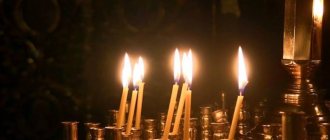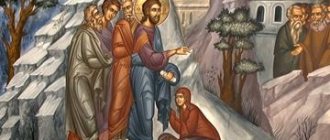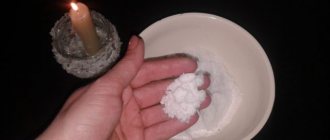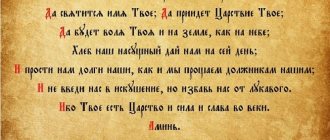An invariable attribute of any Orthodox person is an icon. It symbolizes faith in the highest, protects from bad things. On the icons the masters depict the faces of saints, the Mother of God, and Jesus. First of all, the prayer is addressed not to the canvas with paints, but to the one who is depicted. The task of the icon is to create a kind of spiritual bridge through which a person can come to the Lord.
Since ancient times, icons have protected the house and owners from evil forces and helped in difficult situations. Spiritual culture, having passed through millennia, has shaped the spiritual world of a believer, and is reflected in the form of these works of art. A rite of consecration must be carried out over any icon. Using special prayers before consecration, the amulet receives the Lord's blessing, and at the end it is sprinkled with water. Generally speaking, the image of the saints becomes a mediator in prayer between the earthly worlds and the Divine.
Read the article: Prayers for the sanctification of every thing
Previously, there was no need to consecrate icons
Our ancestors did not think about how to consecrate an icon. In the church or at the monastery there were people who were icon painters. These are not just artists, but those whose calling is to paint Christian images.
Creating an icon is not only a craft and a creative process, but also a spiritual act. Not everyone was allowed to see him. What was needed was a pious man who not only approached his work with reverence, but also followed the Law of God.
The priest sprinkles the icon with holy water. This is an important moment when consecrating the image. This is how the grace of the Holy Spirit is transmitted to him. Photo: spirovo.ortox.ru
All instruments were often made nearby, using holy water. And so it turned out that in the end, not just an image was born - but an image sanctified due to what it was made of and by whom.
Was it necessary to consecrate such icons? Not at all.
Text of the prayer for the consecration of the icon
It is recommended to consecrate the most holy paintings in church. The rite of consecration must be performed by a clergyman. At home you can say this short prayer:
“By the grace of the Holy Spirit and the sprinkling of holy water, this image is sanctified and blessed. In the name of the Father, and the Son, and the Holy Spirit. Amen".
This phrase is said three times before a new image of the saint. You need to sprinkle the drawing with holy (baptismal) water. Any painting that depicts God or martyrs is considered holy and must be treated with respect. The image acquires true holiness after church consecration.
The rite of blessing and consecration of icons
Priest: Blessed be our God always, now and ever, and unto ages of ages.
Reader: Amen. Glory to Thee, our God, glory to Thee.
To the Heavenly King: Trisagion. Most Holy Trinity: Our Father: Priest: For Thine is the kingdom: Reader: Amen. Lord, have mercy, 12. Come, let us worship: three times.
Psalm 88
I will sing of Your mercy, O Lord, forever, I will proclaim Your truth with my mouth to generation and generation. Thou hast declared: mercy will be created forever, Thy truth will be prepared in Heaven. I have made a covenant with my chosen ones, I have sworn an oath to David my servant: I will prepare your seed forever, and I will build up your throne for generations and generations. The heavens will confess Your wonders, O Lord, for Your truth is in the church of the saints. For who in the clouds can be equal to the Lord? Will he become like the Lord in the sons of God? God is glorified in the council of saints, He is Great and Terrible above all those around Him. Lord God of hosts, who is like You? Thou art strong, O Lord, and Thy truth is all around Thee. You rule over the power of the sea; you tame the disturbance of its waves. Thou hast humbled Thou as the plague of the proud, Thou hast squandered Thy strength with the arm of Thy enemies. The heavens are Yours, and the earth is Yours, You founded the universe and its fulfillment. You created the north and the sea, Tabor and Hermon will rejoice in Your name. Thy arm is with strength: let Thy hand be strengthened, and Thy right hand be exalted. Truth and destiny are the preparation of Thy Throne: mercy and truth shall come before Thy face. Blessed are the people who cry out: Lord, in the light of Your face they will walk, and in Your name they will rejoice all day long, and in Your righteousness they will be exalted. For You are the praise of their strength, and in Your favor our horn will be exalted.
Also the deacon: Let us pray to the Lord.
Lik: Lord, have mercy.
The priest reads a prayer
Lord Almighty God our Father, glorified and worshiped in the Trinity of Saints, Whom neither the mind can comprehend, nor a word can say, Whom no one has seen from man anywhere, just as we have learned from the holy scriptures, here we believe and herein You, God the Father without beginning, and the Son We confess Your Consubstantiality and Your Spirit with the Throne. Like in the Old Testament, in Your appearance to Patriarch Abraham in the form of Three Angels, in the last days after the incarnation of the Only Begotten Son of God, our Lord Jesus Christ from the Ever-Virgin Mary, in the baptism of John on the Jordan, in the most luminous transfiguration on Tabor, and in the glorious ascension on Olivet, appearing, you showed us the image of the Holy Trinity; also the miraculous image of our Lord Jesus Christ, not made by hands, was depicted by Him on the ubrus, and was sent to the Edessa prince Abgar, and thereby healed many people suffering from various ailments, and taught us to honor this; Likewise, do not reject the images and likenesses of Your saints, but accept them. Even now, look upon these icons, which are Your servants, in honor and glory to You, the one in the Trinity of holy glorified God, and Your Only Begotten Son, our Lord Jesus Christ, His Most Pure and Most Blessed Mother, our Lady, the Most Holy Theotokos and the Ever-Virgin Mary, and in memory Having built Thy saints [name], bless and sanctify them, and give them healing power to drive away all the snares of the devil, and in all things that pray diligently before them, be heard, and attract the mercy of Thy love for mankind, and create grace to receive. For You are our sanctification, and to You we send glory to the Father, and the Son, and the Holy Spirit, now and ever, and unto ages of ages.
Lik: Amen.
Priest: Peace to all.
Lik: And to your spirit.
Deacon: Bow your heads to the Lord.
Lik: To you, Lord.
Previously, icons were single-piece items, but now, due to commerce, anyone can make them
But over time, Orthodoxy in Rus' acquired colossal proportions. The number of believers increased, and the religion itself began to transform. If previously the church served as a place where people communicated with God and with each other, then later they began to pay more attention to paraphernalia.
It's good? Badly? Honestly, it's always better when a person gets to the point. We must live according to religion, and not limit ourselves to the cult of objects.
XVII
century, when the demand for icons increased in the homes of Russian believers
No, there is nothing wrong with wanting to have an image of a saint with you. On the contrary, it is a way to pray with concentration, plus there is always an example of spirituality before your eyes.
But the whole trouble is when an icon turns into an object of some kind of cult, when a person imagines that possessing it in some way already makes him a pious Christian.
By the 17th century, the demand for icons increased. The masters remained, but it is clear that they were far from able to satisfy the demand for icons among believers.
The emphasis on mass appeal made icon painting a craft.
They were no longer drawn by pious artists, but by people who simply made a living from it.
Then factory icons appeared altogether. So it is not surprising that believers want to return to tradition and purchase not just an image, but a consecrated icon for their home.
The image for consecration must comply with the canons
The question of the consecration of icons was first raised in the Western Church. There is nothing to be surprised here, because such processes have always occurred more dynamically there. And Western progress has always been ahead of what was happening in Rus'.
However, these trends have reached us too.
In addition, the situation was complicated by the fact that many people themselves began to paint icons at home. Sometimes these were images that deviated greatly from the canonical ones.
Amateur icon painters often create non-canonical images; they cannot be consecrated.
What is a canon in icon painting? This is strict symbolism, the inner essence of the image. If you step back from it, we are no longer faced with an icon, but with a picture. It is noteworthy that in the Russian Orthodox Church they are especially attentive to the canon. This is a legacy of the Byzantine approach.
But the Catholic world is a little more free with images of saints. But there they venerate icons a little differently. We value them more.
Important !!! About the consecration of icons
We are often asked, “Are your icons consecrated?” Since our mission is not to sell you our icons by hook or by crook, but to bring into your homes images that will attract you to prayer (this is a rough interpretation, later there will be a whole, voluminous post about our mission ), conversation with God, the Mother of God, the Heavenly Powers, the saints. First of all, we want to be responsible before God for our deeds, which is why we do not hide the LINK; another link is that we do not consecrate the icons in the temple for several reasons. Firstly, we cannot guarantee due attention when sending and delivering the consecrated Image to the addressee. As one priest we know told us: “... it is more useful for a person to go to church with his icon and consecrate it himself, especially since it does not take much time (1 prayer), but will add benefits. After all, no one pays money for someone to confess for you or keep a fast...” Secondly, about 10 years ago, when we consecrated icons before delivering wholesale shipments, they were laid out again to be consecrated, regardless of the fact that they had been consecrated. We asked ourselves what the rite of consecration is and what its meaning is. Below are the words of Archimandrite Zinon, who explains everything clearly.
“According to this order, which is contained in our breviaries, in the old days icons were not consecrated. For the first time it is found only in the great breviary of Peter Mogila. There is no such rank in any breviary of the Moscow Donikon press. It is called the rite of blessing, not sanctification, and should be considered as the Church’s approval of this image, but not as some kind of sacramental act. (After all, it would not occur to anyone, having bought a new Gospel, to consecrate it before starting reading.) An inscription was placed on the icon, after which it was considered consecrated. It is not the substance that is venerated, but the person depicted. The inscription is necessary, as they used to say, in order for the spirit of the person praying to be established, that is, so that the person praying knows exactly who he is addressing, because the iconography of many saints is similar. For example, if the icon of St. Kirill of Belozersk is not signed, he could be mistaken for St. Sergius or one of the ancient saints.”
PS Some ignorant or unscrupulous distributors may claim that the icons were consecrated, or made in the Diveyevo monastery, or all the faces were painted by the nuns of the monastery. Don't believe it! ALL ICONS of the Diveyevo art workshop, and SIMILAR TO OURS, are not produced in the monastery, these are all private workshops not related to the monastery, except for love and the desire to be closer to this holy place.
An icon should also be consecrated if the image is desecrated or if its origin is unclear
But priests recommend lighting not only homemade and industrial icons; there are different circumstances:
- the icon was desecrated;
- the icon was restored;
- the icon was given as a gift, and we have no idea whether it was consecrated before;
- found the icon.
In each of these cases, we are dealing, as it were, with a new icon, into which the grace of the Holy Spirit must enter through the rite.
Antique icon of the Kazan Mother of God. It is usually impossible to find out whether such an icon was consecrated. Priests recommend consecrating them
To consecrate an icon, you need to contact a church worker or priest
Careful attitude towards the canon contributes to the fact that not every image of a saint can be consecrated. The Holy Spirit, as is commonly believed, will wish to enter only those images that are written according to all established rules.
The decision on whether an icon can be consecrated in a church is made by the priest. Anyone wishing to use this service should adhere to the following procedure:
- In church, contact the person who takes orders for services. Usually this person works at the entrance. We agree with him about when it will be convenient to communicate with the priest.
- If you have the opportunity to meet the priest in person, then the first point can be neglected.
- Then you agree on everything individually. There are no rules about what and how to do.
- As for payment, the church should not set tariffs for its services. Remuneration is a voluntary action, and its size is determined by the person himself. Unfortunately, there are other precedents. But this is already a question about the integrity of individual clergy.
An image received in church does not need to be consecrated
There is an unspoken law that churches and monasteries must distribute only consecrated icons. This tradition originated in ancient times and is still observed today. If the most holy image was purchased in a temple or church shop, it does not need to be re-consecrated. Some churches sell consecrated images of saints online. The second time, church images purchased in a virtual store are not consecrated.
The purchased consecrated painting can be brought home and hung on the wall or placed on a shelf. The most holy image can be in any room: bedroom, living room, hallway, kitchen. It is recommended to place the image of the saint on the eastern wall. It is customary to pray facing East. There should be no obscene paintings near the holy image. It is advisable not to place images of saints in passage rooms.
It is customary to pray in silence and solitude. You can put the image on a shelf in your office or hang it in your bedroom. When communicating with the Higher powers of a person, nothing should distract him. You can light a candle before praying. This is a symbol of the spiritual connection of a praying person with the Savior. At the end of the prayer, it must be extinguished. The texts of all prayers are in prayer books.
For consecration, the priest reads a prayer and sprinkles the icon with holy water
Icons are blessed with holy water - not dipped, of course, but sprinkled. They also burn incense. At the same time, the priest reads a prayer.
Which one? It greatly depends on what kind of holy image is in front of him. Depending on the circumstances, a variety of ranks may be chosen. This includes the rite of consecration of various icons.
Regardless of the chosen prayer, the icon will be illuminated.
Some icons are not consecrated because of their content. For example, “Blessed Matrona blesses Joseph Stalin,” once exhibited in the Church of the Holy Equal-to-the-Apostles Princess Olga in Strelna, demonstrates a plot that is not acceptable for Christians. After a barrage of criticism on this image, it is unlikely that at least one priest will undertake to consecrate an icon on the same topic. Photo: cs.pikabu.ru
How an icon is illuminated in a temple
How does the rite of blessing and consecration take place in the church:
- The priest begins with the words: “Blessed is our God always...”. Then the reader says: “Amen...”. They read: “To the King of Heaven. Trisagion. Holy Trinity. Our Father".
- After the prayers, the words of Psalm 88 are said: “Your mercies, O Lord, I will sing forever...”.
- The deacon says: “Let us pray to the Lord.” The chorus answers: “Lord, have mercy.”
- The priest says the words of the prayer: “Lord Almighty, God of our fathers, glorified in the Holy Trinity...”.
- The choir sings: "Amen." The priest says: “Peace to all.”
- The priest bows his head and secretly reads the prayer: “Beginless, invisible and incomprehensible Lord!...” Then he proclaims: “For you bless and sanctify everything...”. The choir sings: "Amen."
- The priest sprinkles the icons with holy water three times and says: “These icons are sanctified by the grace of the Most Holy Spirit...”
- After sprinkling, the priest censes the icons, bows before them, and kisses them.
- The choir sings holiday troparia.
- At the end, dismissal is pronounced.
Important! Having bought an iconographic image not in a church shop, you need to come to church with it and negotiate with the clergyman about the consecration. If the painting was painted according to canonical rules, the temple will tell you when to bring it to be sprinkled with holy water.
Icons purchased at the church have already been consecrated
Icons that are sold at the church do not need to be illuminated. It is understood that any church goods have already been blessed in advance before they are put up for sale.
If some church, in addition to the total cost, offers the “service” of consecration for an additional fee, then it makes sense to file a complaint with the diocese, because this is already speculation that discredits the image of the Russian Orthodox Church.
Where should icons be located in an apartment?
Only a priest can consecrate an icon independently.
The Internet is full of instructions on how to consecrate an icon at home. “Prepare holy water,” “take the cross,” “read a prayer.”
For the Russian Orthodox Church this is nonsense. Only the official representative of the Church of Christ, a priest, can consecrate icons. He has spiritual authority to do this.
A layman should be interested in how to consecrate an icon in a church or at home with the help of a priest.
Everything else is a practice alien to Orthodox Christianity.
Self-embroidered icon in a frame Photo: tonus-stroy.net.ru
Such embroidery kits are very popular among believers. But the chance that the finished product will be blessed by a priest is not great. They put their soul into a real icon, and such images often require only perseverance and nothing more.
Rite of consecration at home
The church allows you to consecrate small purchases yourself, using prayers from the Trebnik. But first you need to familiarize yourself with the rules of its conduct and follow them strictly.
What is it needed for
Any object carries the energy of the people who come into contact with it, and therefore can accumulate their negative emotions. The consequence of this for the new owner may be headaches, poor health, quarrels and scandals. And only sanctification will relieve the negative impact.
Necessary materials
Having tuned in spiritually, you need to prepare something else.
Required attributes for the ritual:
- Holy water from the temple.
- An image with the face of St. Nicholas the Wonderworker. You can also use an image of your saint, whose name was adopted at baptism.
- Church candles. How many pieces - you need to check with the priest.
- A prayer book, or better yet a Breviary, because it contains a large number of universal prayers.
It is more effective to use a prayer text intended for a specific thing.
Rules and instructions for conducting
The process itself is quite simple. The main thing is to believe that everything will happen exactly as planned.
How the ritual happens:
- Prepare a clean place (table, chair) and a fresh towel.
- Place the consecrated object on it.
- Say a prayer three times and sprinkle with holy water.
- Wipe the item and you can use it.
The entire ritual takes about 10-15 minutes. It is advisable that no one is at home at this time.
Even if the icon is not consecrated, it deserves respect
And if the icon is not consecrated, what is it - a trifle? Of course not. Although the Church points out the importance of consecration, even without it the icon remains an image of grace, which for believers is an object of veneration.
In the history of the Russian Orthodox Church, there are cases when unconsecrated icons even streamed myrrh. So what matters is not what rituals we went through to create the image, but how we relate to it.
But at the same time, we should not forget that we do not honor the icon, but the holy man who is depicted on it. And we pray not to him, but to God, we simply ask the saint to join our prayer.
An icon made of beads or embroidered can also be consecrated in a church, if the image is canonical and made with soul
How to consecrate an icon made of beads? In the church. How else? It doesn’t matter what tool or what the image was created on. It is important how much soul there is in it and how it corresponds to church canons. But the important question is not “is it possible to consecrate an icon made of beads?”, but “is it necessary?”
In fact, a person has a passion for handicrafts. This is wonderful. He made a product with a religious theme. Also good. But why is sanctification necessary?
A handmade icon does not have to be consecrated; it can simply serve as decoration.
An icon made of beads may well become an interior object that will remind you of the lifestyle of a pious Christian. Why not?
The same applies to the question of how to consecrate an embroidered icon in a church. A holy image from any material can be consecrated. But not every image is suitable for this. Beautiful - yes, does it correspond to the canons - the question is.
Archpriest Alexander (Saltykov) comments on this situation as follows:
“To understand which images can be consecrated as icons, and which cannot, a priest needs to study. We must learn Orthodox dogma and Orthodox piety.
Then it will be clear to him that, for example, interpretations of the Holy Family, depicting the embrace of righteous Joseph and the Virgin Mary, are not only unacceptable, but also have a blasphemous element. We must study, then the boundaries of what is permissible will be clear.
In general, creativity is a good thing, but everything should have its place and its space. If a person presenting a picture as an icon is offended, then he needs to be taught the Orthodox faith. It is necessary to explain, using the same example, that Joseph is not the husband of the Virgin Mary, he is not her secular admirer, this is blasphemous.
If they are upset, it means we are not explaining to them well, we are not praying for them well. The short answer is that, of course, it is possible to consecrate homemade icons, including those embroidered and made of beads, but here the main criterion for the priest is piety, canons and church culture. To understand all this you need to study, study and study again.”
Alexander Saltykov
archpriest
So you should be prepared for the fact that the priest will refuse to consecrate this or that image. This is not a sentence. We have enough icons for prayers around us. And the value of the product does not depend in any way on consecration.
Archpriest Vladimir (Golovin) says in the video that the question of whether to consecrate an embroidered icon or not must be decided on an individual basis.
A person must make an icon with his soul. If this is visible, then the image should be consecrated, otherwise there will only be a picture:
Is it possible to embroider icons yourself? (Protege Vladimir Golovin, Bolgar)
By leaving a comment, you accept the user agreement
Ways to Make Prayer More Effective
Only faith will make the Higher Powers hear requests, and it can be strengthened by constant prayers and visiting church. While at the service, it is necessary to repeat its words during the liturgy. It is best to retire and abandon problems, think that everything is God’s will, because he alone is able to remove all obstacles and protect from adversity.
Only when you are in church can you experience a blissful state, because pure thoughts dwell there, because in church they pray for everyone - both the righteous and the sinners. Therefore, if you read a prayer for the consecration of a thing here, it will have special power, since it will be filled not only with the energy of a person, but also with the energy of the entire Christian egregor.










